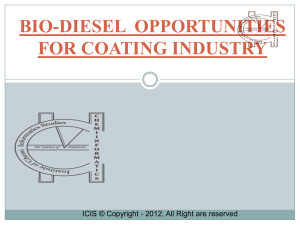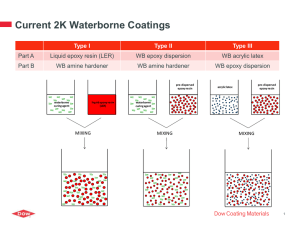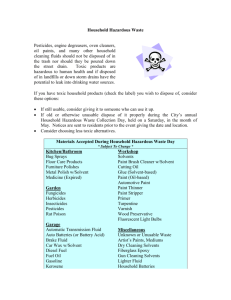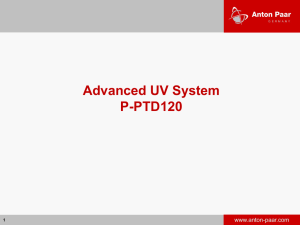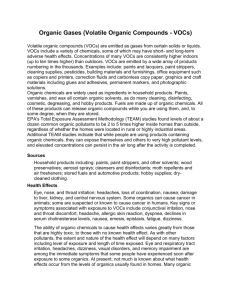revised Safety aspects of coatings
advertisement
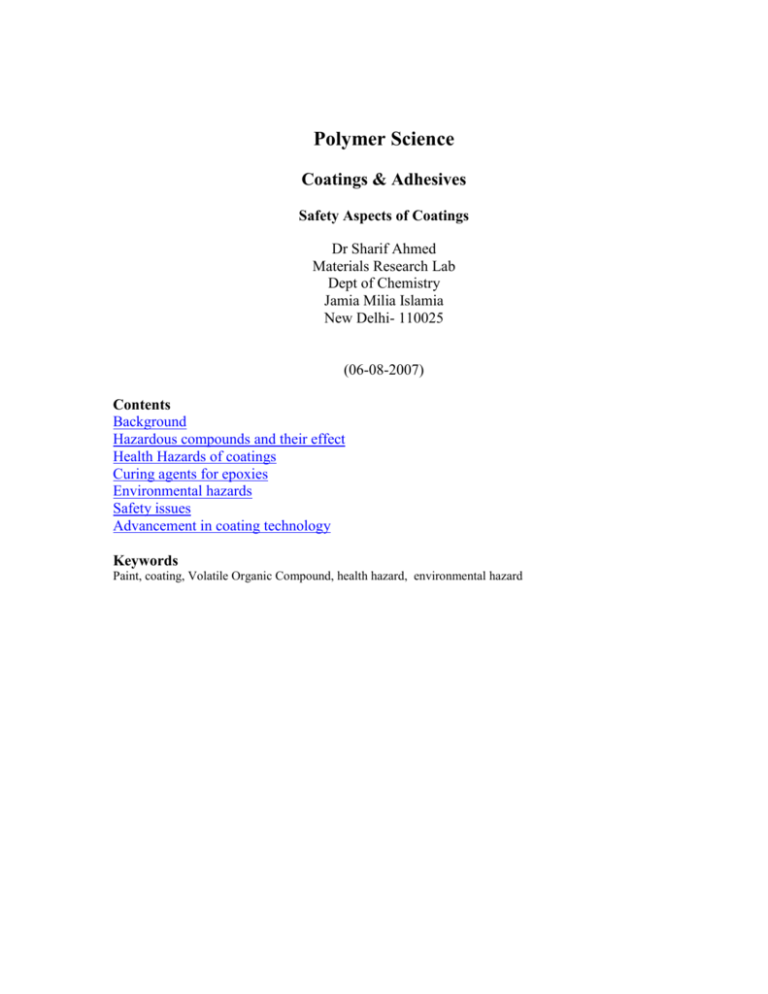
Polymer Science Coatings & Adhesives Safety Aspects of Coatings Dr Sharif Ahmed Materials Research Lab Dept of Chemistry Jamia Milia Islamia New Delhi- 110025 (06-08-2007) Contents Background Hazardous compounds and their effect Health Hazards of coatings Curing agents for epoxies Environmental hazards Safety issues Advancement in coating technology Keywords Paint, coating, Volatile Organic Compound, health hazard, environmental hazard Background In the early 1970s, more than 90% of paints and coatings worldwide consisted of solids (5-20% by weight) solvent borne coatings. The desirable performance of coatings could be achieved at a reasonable cost using conventional solvent borne paint formulations, during that period. However, in the past two decades, research and development efforts in the field of coatings and paints have undergone paradigm changes out of three major driving forces: (i) low cost, high performance, good quality paints and coatings- The ever growing consumer expectations of good quality and performance coupled with lower cost were the major driving forces for research and technological innovations in this field. Customer demands for Total Quality Management (TQM) and ISO certification have emphasized on establishing quality control in manufacturing processes in paints and coatings industries, at cheaper rates [1,2]. (ii) concerns related to energy consumption- The oil crisis that occurred in 1970s forced many manufacturers to change their gears due to the escalating prices of raw materials because of shortage of feedstocks. There occurred an urgency to develop coating materials that either contained less solvent or involved less energy curing process (considering the cost associated with operating the ovens used to volatilize solvent(s) during curing process) [1,2]. (iii) health hazards and environmental contamination- The hazardous air pollutants (HAPs) and volatile organic compounds (VOCs) released in atmosphere during manufacture and application of coating materials lead to environment contamination and serious hazards to human health. The paint industry has been under immense pressure to voluntarily reduce the amount of solid wastes and air pollutants generated during the manufacture and application of coating materials, since past two decades. The environmental regulations and government legislations to move towards zero waste generation during the development as well as application of coating materials has been the dominant driving force [1,2]. Resource Conservation and Recovery Act (RCRA), Comprehensive Environmental Response Compensation and Liability Act (CERCLA), Clean Air Act (CAA) of 1970 and subsequent amendments in 1977 and 1990, focus on the attainment and maintenance of healthy environment by controlling the HAPs in atmosphere, reducing the generation of acid rain, reducing and monitoring the release of VOCs, HAPs and chlorinated solvents in the atmosphere and protecting the ozone level in the outer stratosphere. The chapter focuses on the hazardous substances in paint and coating formulations, which prove detrimental to health of humans as well as the environment, health and environmental hazards caused by aforementioned substances and safety issues during manufacture and application of coatings. Hazardous Compounds and their effect on Human Health and Environment A paint or coating formulation usually comprises of binder, pigment, solvent/diluent’s and additive. The amount of each constituent varies with the particular paint, but solvents traditionally make up about 60% of the total formulation. Binders account for 30%, pigments for 7 to 8%, and additives for 2 to 3%. Before proceeding further, it is important to gain a basic idea about these constituents [3-6]. (1) Binders: are liquid polymeric or resinous materials that are used in coatings to hold the pigment and additives together, to provide adhesion, and to enable the coating to cure into a thin plastic film. The binder determines the performance of the film, including flexibility, durability and chemical resistance. Most binders are named for their main resin. The resins most commonly used in paints and coatings are natural oils or vegetable oils, alkyds, polyesters, aminoplasts, phenolics, polyurethanes, epoxies, silicones, acrylics, vinyls, cellulosics, fluorocarbons and others. (2) Pigments: are insoluble particles of organic or inorganic materials (either natural or synthetic) that are dispersed in a coating in order to confer color and opacity to a substrate, or to improve the substrate's environmental resistance and the flow properties of the paint. The type of pigment in the paint determines the color and color stability of the paint or coating, while the amount of pigment determines the gloss, hiding power and permeability of the coating. Inorganic pigments have high thermal stability and ultraviolet light stability. Organic pigments are brighter and clearer than inorganic pigments. Examples of some commonly used pigments are red/yellow/black iron oxide, titanium dioxide, limestone and clay, barium metaborate, barium titanate, nickel, copper, silver powders and others. (3) Additives: are materials that improve the physical and chemical properties of the coatings. Additives include surfactants, colloids and thickeners, biocides and fungicides, freeze/thaw stabilizers, coalescing agents, defoamers, plasticizers, flattening agents, flow modifiers, stabilizers, catalysts and antiskinning agents. A coating's characteristics can change significantly depending on which additives are included. (4) Solvents: are added to coatings to disperse the other constituents of the formulation and to reduce viscosity, thereby enabling application of the coating. A wide variety of solvents are used in paints, including aliphatic hydrocarbons, aromatic hydrocarbons (toluene, xylene, and the trimethyl benzenes), ketones (methyl ethyl ketone-MEK and methyl isobutyl ketone-MIBK), alcohols, esters and glycol ethers. Some of these solvents prove carcinogenic in nature (as discussed in proceeding units). Several chemicals, pigments, binders that were once considered as integrated and indispensable inputs of paints and coatings industries are now regarded as hazardous chemicals. Chemicals such as isocyanates, amine curing agents, acrylics, vinyls, lead, tin and chromate based pigments, aromatic hydrocarbons such as benzene, chlorinated hydrocarbons like trichloroethylene, perchloroethylene and methylene chloride cause serious effects to health and environment. When solvent vapors are released, they emit volatile organic compounds (VOCs) and hazardous air pollutants (HAPs) into the atmosphere. VOCs combine with nitrogen oxides in the presence of sunlight to form ground-level ozone. Ground-level ozone is a precursor to smog, a major pollutant in urban and industrial areas. Smog poses a number of human health risks to respiratory function, particularly among persons with asthma or allergies. In the following sections, these hazardous agents have been discussed in consideration with their detrimental impact to health and atmosphere [7]. Health hazards of coatings during manufacture and applications Some of the common ingredients of paints, which had been previously opted as workhorses of paint industry have now been categorized as hazardous materials. Undoubtedly, this has actually been an outcome of advancements in technological approach as well as serious threat they pose to the health of workers and other persons exposed to them during manufacture and applications. Though the symptoms of adverse effects of substances used in coatings and paint formulations were evident in as early as 1950s, articles appeared in 1991 about the illnesses that struck painters [8-10]. (i) VOCs-Volatile Organic Compounds (VOCs) are chemicals that evaporate easily at room temperature. The term “organic” indicates that the compounds contain carbon. VOCs are generally used in manufacture, degreasing, cleaning and as solvent in paints. VOC exposures are often associated with an odor while at other times there is no odor at all; both can be harmful. There are thousands of different VOCs produced and used in our daily lives, emitted or given off by several manufacturing processes and products such as paints, varnishes [11], moth balls, cosmetics, air fresheners, solvents and others. Common examples of VOCs are hydrocarbons such as alkanes, alkenes, aromatics viz. 1,3 butadiene, toluene, xylene, oxygenates e.g., alcohols, aldehydes, ketones, ethers and halogen containing species viz. methylene chloride. Methane (CH4) is another important component of VOCs. Some health effects of common non halogenated solvents commomly employed in paint formulations are listed in the Table 1. The use of solvents such as benzene is also being avoided these days due to reasons of carcinogenicity [3,816]. Table 1 Health effects of some common solvents used in paint formulations [3] Toluene Central Nervous System dysfunction, narcosis, fatigue, sleepiness, headaches, nausea, cardiac arrhythmia, impaired speech, hearing and vision, eye irritation, dizziness, cerebral atrophy, nystagmus (involuntary eye movements) Xylene Nose and throat irritation, gastrointestinal effects such as nausea, vomiting, gastric and eye irritation, headaches, dizziness, fatigue and tremors, labored breathing and impaired pulmonary function, increased heart palpitation, severe chest pain, possible effects on blood and kidney, neurological effects Methyl ethyl Eyes, nose and throat irritation, central nervous system depression, ketone reduction of foetal development and foetal malformations in mice Health effects of VOC exposure may vary from acute to chronic e.g., eye, nose, throat irritation, headaches, nausea, loss of coordination, allergic skin reaction, dyspnea, decline in serum cholinesterase levels, asthma exacerbation to liver, kidney, central nervous system damage and cancer (Fig.1). Persons with respiratory problems such as asthma, young children, elderly, and persons with heightened sensitivity to chemicals may be more susceptible to illness from VOC exposure. Often, neurological disorders may also result e.g. Ortho Neuro Pshychology Syndrome (ONPS) [12-15]. Benzene is a known and 1,3-butadiene is a suspected human carcinogen [3]. Antifouling coatings contain solvents, which are harmful by inhalation and by skin or eye contact. They can have a narcotic effect resulting in the following symptoms: headache, dizziness, irritability and mental confusion. Skin contact can cause defatting of the skin and dermatitis. (ii) HAPs- Clean Air Act, 1990 considered 189 chemicals, metals and particulates as Hazardous Air Pollutants, commonly referred to as HAPs. These pollutants are known to increase the risk of developing cancer, immune and neurological damage, reproductive and endocrine disorders, and birth defects in children [7]. For this reason, federal regulations of these substances are more rigorous. Benzene, toluene, vinyl chloride, perchloroethylene, arsenic, mercury, diesel particulates and various pesticides are included on the list of HAPs. The common environmental problem associated with these is reduced visibility due to haze. (iii) Isocyanates- Isocyanates are a group of low molecular weight aromatic and aliphatic compounds containing the isocyanate group (-NCO) [18,19]. They are one of the basic raw materials used for the synthesis of polyurethanes, widely used in the manufacture of flexible and rigid foams, fibres, coatings such as paints and varnishes, adhesives and elastomers. Common examples of isocyanates are toluene di-isocyanate, diphenyl methane di-isocyanate, hexamethylene di-isocyanate, naphthalene di-isocyanate, methyl isocyanate [4,19]. The harmful effects of isocyanates become visible following inhalation of free isocyanate groups in vapour, mists and particles or eye and skin contact with liquid or vapour isocyanates. It is also important to note that free –NCO groups of isocyanates get comsumed during chemical reaction and also lose their carcinogenicity, during the process. Some new moiety, depending upon the type of reactant (such as amine, water, hydroxyl containing compound and others) gets incorporated into the backbone of the polymer after polymerization. In the monomer or pre-polymer forms, TDI and HDI pose a greater health hazard than other commonly used isocyanates. Because of its inherent toxicity, higher volatility and widespread use, TDI presents the greatest overall hazard among all isocyanates, and exposure can occur at all stages of its manufacture and use. Isocyanates are commonly dissolved in aromatic solvents such as xylene and toluene, which are themselves toxic in nature. In relatively high concentrations, isocyanates have a strong irritant effect on the respiratory tract in most people. Some people may develop bronchial sensitivity to isocyanates. These people, when later exposed to even very low concentrations of isocyanates, which may be below the exposure standard, may react by developing asthma-like symptoms, such as chest tightness, cough, wheeze and shortness of breath. Skin sensitisation occurs rarely with TDI, but may be more common in the case of other isocyanates. Isocyanates are considered irritant to the eyes. Splashes can cause severe chemical conjunctivitis. Other health effects, which have been reported, include liver and kidney dysfunction. The Bhopal gas disaster, a catastrophic industrial accident, was due to a leak of toxic gas, methyl isocyanate (MIC), in the pesticide manufacturing process [20]. (iv) Pigments- Lead, cadmium, mercury and zinc were commonly used as pigments, in paints and coatings industries for both aerospace and semi-conductor devices. However, legislations have been introduced putting pressures on manufacturers to limit their use in their products. A long time exposure to lead is very dangerous for human health. The risks are greater for children than for adults, because children's growing bodies are able to absorb lead more easily [21]. Even small amounts of dust containing lead are dangerous to infants and children. Lead poisoning can cause anemia. It can also damage the brain and nervous system, resulting in learning disabilities. However, lead-based paint in the home poses serious health hazard when it is chipping or flaking. Exposure to lead causes neurotoxic effects, haematologic and renal effects, reproductive and developmental effects, cardiovascular effects and carcinogenic effects. One of the major targets of lead toxicity in adults is the nervous system, including the central and peripheral nervous systems. Lead damages the blood-brain barrier and, subsequently, brain tissues. Severe exposures resulting in blood lead levels (BLLs) > 80 µg/dL may cause coma, encephalopathy, or death. Workers with BLLs of 40 to 50 µg/dL may experience fatigue, irritability, insomnia, headaches, and subtle evidence of mental and intellectual decline [22,23]. Anemia is one of the most characteristic symptom of high and prolonged exposures to lead associated with BLLs > 80 µg/dL, which results from the damaging effects of lead on the formation and functioning of red blood cells. Lead inhibits the synthesis of heme (the nonprotein, iron-containing component of hemoglobin) and damages the ion transport system in red blood cell membranes. High exposures to lead produce stillbirths and miscarriage [24], hypertension and cardiovascular diseases [25]. Lead has been shown to be an animal carcinogen. Several studies have examined the relationship between workers' lead exposure and the occurrence of cancer among these workers [2628]. Cuprous oxides and cuprous thiocyanate are harmful if swallowed. Inhalation of droplets of copper salts is reported to cause irritation of nasal mucous membranes and sometimes of pharynx. It has an occupational exposure standard (OES) for dusts and mists of 1mg/m3 over an eight hour reference period This reflects the level of exposure at which there is no indication of risk to the health of people exposed by inhalation day after day. (v) Epoxy Resins- Epoxy products are used for paints and surface coatings, molded and reinforced plastics, electronic component potting resins, and adhesives ranging from spray foams to dental cement. They are often used in areas where tough, durable coatings or adhesives are needed. Epoxy resin systems are made up of an epoxy resin and a curing agent (also called a hardener or catalyst). Many epoxy products also contain additives such as organic solvents, fillers such as fiberglass or sand, and pigments. When epoxy resin systems are used, single molecules (monomers) of epoxy resin and curing agent combine to form long chains of molecules (polymers). As the mixture (dry sets) "cures," it becomes a hard polymer. Some epoxies cure in a few minutes at room temperature. Others need additional time or heat to harden. The characteristics of hardened epoxies (such as whether they are firm or flexible, or resistant to heat or chemicals) depend on which epoxy monomers, curing agents, solvents, and fillers are added. The hardened, finished polymers are almost non-toxic; however, the exposure to the uncured resin components can be harmful. In a two-component epoxy product, the epoxy resin and the curing agents are packaged separately and mixed together just before being used. Each component can be hazardous. In a single-component product, the resin and the curing agent are supplied in a pre-mixed form. Single-component systems are usually safer, because the hazardous chemicals are already partly combined into less toxic polymers and because they do not evaporate into the air as easily. The most common effects of overexposure to the chemicals used in epoxy resin systems are eye, nose, throat, and skin irritation, skin allergies, and asthma. Chemicals in some epoxy resin systems have additional health effects. Finished, hardened epoxy products are practically non-toxic unless they are cut, sanded, or burned. The chemicals in epoxy resin systems can affect our health when they come in contact with skin, or if they evaporate or form a mist or dust in the air we breathe. The main effects of overexposure are irritation of the eyes, nose, throat, and skin, skin allergies, and asthma. The solvent additives can cause other effects such as headaches, dizziness, and confusion. The solvents and resin solutions have affected the lungs, skin, eyes, nose and throat as follows. Lungs: Vapors and spray mists of most epoxy resin system chemicals can irritate lungs. Some people develop asthma from the curing agents. Symptoms of asthma include chest tightness, shortness of breath, wheezing, and coughing. These symptoms may occur after work or at night. Once a person becomes allergic to curing agents, even the dusts from sanding or grinding the hardened plastics can cause an asthma attack. Skin: Epoxy resins can cause skin irritation. Symptoms include redness, swelling, flaking, and itching on the hands, face, or other areas of contact. Some people develop a skin allergy or sensitivity to epoxy liquids or mists. Skin allergies may develop after just a few days of contact or after many years of exposure to epoxies. Sensitized skin may become red, inflamed, blistered, and itchy even from brief contact with epoxy resins. Eyes, Nose and Throat: Most epoxy resin system chemicals and their vapors (especially the curing agents and solvents) can irritate our eyes, nose, and throat. Some people develop headaches as a result of this irritation. If the liquids are splashed into eyes, they sting, and they can severely damage the eye. In case of eye contact, the eyes should be immediately rinsed with water. Medical attention becomes necessary at this point. Nervous System: Solvents inhaled or absorbed through the skin can affect the central nervous system the same way drinking alcohol does. Symptoms of solvent overexposure include headache, nausea, dizziness, slurred speech, confusion, and loss of consciousness. Cancer: Older epoxy resins caused skin cancer in laboratory animals. This may have been due to epichlorohydrin, a contaminant that can probably cause cancer in humans. Most epoxy resins, which contain less epichlorohydrin, do not seem to cause cancer in animals. Reproductive System: Epoxy resins and curing agents themselves probably do not affect pregnancy and reproduction in humans. However, some of the diluents and solvents in epoxy resin systems may affect reproduction. Two solvents sometimes found in epoxy resin systems (2-ethoxyethanol and 2-methoxyethanol) cause birth defects in laboratory animals and reduced sperm counts in men. Some glycidyl ethers also damage the testes and cause birth defects in test animals. It is not known whether they have the same effects in humans. Curing agents for epoxies (i) Amines- Curing agents based on aromatic polyamines such as m-phenylene diamine and para phenylene diamine were used for solventless epoxy coatings. Their use has been discontinued as these are carcinogenic in nature. Spillage of liquid amine can cause permanent damage to retina and can also cause skin burns. Triethylamine (TEA) is used as a curing agent for epoxies and also as a corrosion inhibitor. Acute, high level TEA exposure (20mg/m3 (4.8ppm) for 8 hours) resulted in reversible ocular effects that included corneal swelling and halo vision in 4 out of 5 persons. Other problems associated with TEA exposure are eye irritation and blurred or foggy vision. It may also result in decreased body weight and decreased water consumption, eye and nose irritation in animals. Ethyleneamines are irritant to the skin [6, 29-34] Diaminodiphenyl sulfone (DDS), a curing agent in some epoxy resin systems, is carcinogenic in laboratory animals. Certain glycidyl ethers used in epoxy products cause genetic mutations in laboratory animals. This suggests that they may be cancer-causing agents. It is not known if glycidyl ethers cause mutations or cancer in humans. Most other components of epoxy resin systems have not been adequately tested to determine if they can cause cancer. (ii) Acid/anhydride-Among common acids/anhydrides used in curing of epoxies and as a co-reactant in the formation of polyesters and polyesteramides are low molecular weight acids/anhydrides viz., phthalic, maleic, trimellitic, acrylic acid/anhydride [19]. Their environmental or health effects are provided below [19]. Phthalic acid/anhydride- is used as a chemical intermediate in plastics and paint industries. In paints and coatings, it is also used as a curing agent for epoxies. The acute (short-term) effects from exposure to phthalic anhydride in humans consists of irritation to the eyes, respiratory tract, and skin; however, no permanent injury has been reported, yet. Chronic (long-term) effects included conjunctivitis, rhinitis, rhinoconjunctivitis, bronchitis and irritation of the skin and mucous membranes of the respiratory tract. Chronic exposure to phthalic anhydride vapor in animals causes congestion, irritation and injury to lung cells. Reproductive, developmental or carcinogenic effects of phthalic anhydride in humans have not been reported, yet. Phthalic anhydride has not been classified for carcinogenicity by EPA. Maleic anhydride- is used in the formulation of resins, as a curing agent for epoxies, as a modifier by undergoing copolymerization with monomers such as styrene, in water borne paints and adhesives. Exposure to maleic anhydride by its accidental releases to the environment or in workplaces where it is produced or used cause acute (short-term) effects such as irritation of the respiratory tract and eyes. Chronic (long-term) exposure to maleic anhydride may cause chronic bronchitis, asthma-like attacks and upper respiratory tract and eye irritation in workers. In rats chronically exposed to maleic anhydride via gavage (experimentally placing the chemical in the stomach), kidney effects were observed. Maleic anhydride has not been classified for carcinogenicity by EPA. Trimellitic anhydride-is used as a hardener in epoxy based powder coatings. Its use has been restricted because of its toxicity and irritancy [19]. Acrylic acid-is one of the common chemicals used in coatings and paints. It is mainly used as a curing agent for epoxy resins, and also as a modifier in water borne paints. Exposure to acrylic acid occurs primarily in the workplace via inhalation and dermal contact during its manufacture or use [35,36]. The health effects of acrylic acid may vary from acute to chronic as provided below. Acute Effects: Acrylic acid is a strong irritant to the skin, eyes, and mucous membranes in humans. The liquid may cause blindness if splashed into the eye [35,36]. Acute (shortterm) exposure of rats to acrylic acid by inhalation has been observed to produce nose and eye irritation, lung hemorrhage, and degenerative changes in the liver and kidneys [37]. Tests involving acute exposure of rats, mice, and rabbits have demonstrated acrylic acid to have moderate acute toxicity by inhalation or ingestion, and high acute toxicity by dermal exposure [38]. Chronic Effects (Noncancer): Information on the chronic (long-term) effects of acrylic acid in humans is not available [37]. In mice and rats chronically exposed to acrylic acid by inhalation, lesions of the nasal mucosa were observed [37]. Reduced body weights and altered organ weights were observed in rats orally exposed to acrylic acid [37]. The Reference Concentration (RfC) for acrylic acid is 0.001 milligrams per cubic meter (mg/m3) based on degeneration of the nasal olfactory epithelium in mice. The RfC is an estimate (with uncertainty spanning perhaps an order of magnitude) of a continuous inhalation exposure to the human population (including sensitive subgroups) that is likely to be without appreciable risk of deleterious noncancer effects during a lifetime. It is not a direct estimator of risk but rather a reference point to gauge the potential effects. At exposures increasingly greater than the RfC, the potential for adverse health effects increases. Lifetime exposure above the RfC does not imply that an adverse health effect would necessarily occur [37]. EPA has medium confidence in the study on which the RfC was based because although it was well conducted and identified a lowest-observedadverse-effect level (LOAEL) for a mild occurrence of the most sensitive effect, a noobserved-adverse-effect level (NOAEL) was not identified, a small number of animals were used, and there is limited description of the nasal lesion reported; medium confidence in the database due to lack of chronic inhalation data; and, consequently, medium confidence in the (RfC) [37]. The Reference Dose (RfD) for acrylic acid is 0.5 milligrams per kilogram body weight per day (mg/kg/d) based on reduced pup weights in rats [37]. EPA has high confidence in the principal studies on which the RfD is based because a sufficient number of animals were used and all relevant endpoints were reported thoroughly; high confidence in the database because it contains two developmental studies and two chronic studies of good quality, all of which are consistent in identifying the critical effect; and consequently high confidence in the RfD [37]. Reproductive/Developmental Effects: No information is available on the reproductive or developmental effects of acrylic acid in humans. Decreased body weight gain and decreased fertility were reported in one study of rats exposed to acrylic acid by ingestion, although the decrease in fertility was not statistically significant compared with the control [37]. Embryotoxic and teratogenic effects (birth defects) were observed in rats injected with acrylic acid [40]. Cancer Risk: No information is available on the carcinogenic effects of acrylic acid in humans. In one study, squamous cell carcinomas of the skin were reported in mice treated topically with acrylic acid. Other animal studies have not reported carcinogenic effects [40,41]. EPA has not classified acrylic acid for carcinogenicity. Paint strippers-are used during home renovations. In contrast to sanding, which produces a lot of dust in air, paint strippers offer one of the least harmful ways to remove lead based paints. Strippers such as methylene chloride have been proved carcinogenic in lab animals. It is a belief that prolonged exposures may prove carcinogenic in humans as well. Environmental hazards VOCs are the main ingredients involved in the formation of ground level ozone and are also precursors to fine particle pollution, both of which can trigger serious health and environmental problems. The major environmental impact of methane is global warming, while that of non-methane VOCs lies in their involvement in the formation of ground level ozone. The majority of tropospheric ozone formation occurs when nitrogen oxides (NOx), carbon monoxide (CO) and volatile organic compounds (VOCs), such as xylene, react in the atmosphere in the presence of sunlight. NOx and VOCs are called ozone precursors [42]. The chemical reactions involved in tropospheric ozone formation are a series of complex cycles in which carbon monoxide and VOCs are oxidised to water vapour and carbon dioxide. Health effects of ozone at concentrations common in urban air are irritation of respiratory systems, reduced lung functions and aggravation of asthma. Smog is a noxious mixture of air pollutants including the following: nitrogen oxides, such as nitrogen dioxide, tropospheric ozone, volatile organic compounds (VOCs), peroxyacyl nitrates (PAN), aldehydes (R'O). Photochemical smog is the chemical reaction of sunlight, nitrogen oxides (NOx) and volatile organic compounds (VOC's) in the atmosphere, which leaves airborne particles (called particulate matter) and ground-level ozone. Nitrogen oxides are released in the exhaust of fossil fuel-burning engines in cars, trucks, coal power plants, and industrial manufacturing factories. VOC's are vapors released from gasoline, paints, solvents, pesticides, and other chemicals. Photochemical smog is a concern in most major urban centres but, because it travels with the wind, it can affect sparsely populated areas as well. Smog is caused by a reaction between sunlight and emissions mainly from human activity. Smog is a problem in a number of cities and continues to harm human health. Groundlevel ozone is especially harmful for senior citizens, children, and people with heart and lung conditions such as emphysema, bronchitis, and asthma [43-45]. It can inflame breathing passages, decreasing the lung's working capacity, and causing shortness of breath, pain when inhaling deeply, wheezing, and coughing. It can cause eye and nose irritation and it dries out the protective membranes of the nose and throat and interferes with the body's ability to fight infection, increasing susceptibility to illness. Hospital admissions and respiratory deaths often increase during periods when ozone levels are high. Tuberculosis is also one of the diseases caused by these agents. Fig. 1. Organs affected by VOCs Most VOCs are non-toxic or present at levels well below guideline values. Others however, such as benzene and 1,3-butadiene (which are internationally being banned, now), are of concern because of their potential impact on human health. In addition to ozone (smog) effects, some VOCs such as formaldehyde and ethylene can also harm plant life. In liquid forms and solutions, VOCs can also affect water and soil. Some environmental effects of VOCs are: Weakens and damages crops and other vegetation vital to healthy ecosystems Contributes to formation of smog Contributes to global warming Some toxic air pollutants such as mercury can deposit onto soils or surface waters, where they are taken up by plants and ingested by animals and are eventually magnified up through the food chain. Like humans, animals may experience health problems if exposed to sufficient quantities of air toxics over time [17]. When in a metallic powdered form, Titanium metal poses a significant fire hazard, and when heated in air, an explosion hazard is probable [41]. Improper disposal of paint and coating materials may also harm the environment. If poured down a drain or sewer system, they have the potential to pollute our groundwater, rivers, and streams posing danger to aquatic life. There is also fear of fire and explosion hazard involving either the liquid or the vapour given off from the liquid. These hazards may occur where vapours or liquids are released into atmosphere where an ignition source is present. Safety issues Coating manufacturers or suppliers hold the prime responsibility to educate the users about safety issues. This includes the workers who are directly involved during manufacturing process of paint and coating material as well as the sprayer or the pot man or any other person who is in close vicinity to the region where paint or coating operations are being carried out. Manufacturers’ or suppliers’ safety data sheet should provide information on the immediate or long term health effects, physico-chemical data such as solvent volatility, relevant exposure limits for various components of coating materials, possible routes of exposures and other relevant or important information. Management of Health and Safety at Work Regulations, 1992, require employers to assess and undertake risks involved in their work activities. The Confined Space Regulations, 1997, apply to places where work pertaining to coatings is carried out in confined spaces. The requirements of CS Regulations are firstly, entry to confined spaces should be avoided, secondly, safe system of work must be followed in confined spaces and lastly, adequate emergency arrangements must be made prior to the onset of work schedule. The Control of Substances Hazardous to Health Regulations, 1994, requires preventing or controlling the exposure to substances hazardous to health. Where possible, hazardous substances should be replaced by less harmful ones. Control measures such as installation of exhaust ventilation should be practiced and sources of ignition should not be introduced in areas where such type of work is being carried out. Exposures can also be avoided by engineering means such as by using automatic mixing units to mix the paint rather than by mixing it by hand, using paint pumps that have a suction unit that can be inserted directly into the paint tin to further avoid spillage, by selecting appropriate nozzles, by adjusting spray pressures to minimize the production of mists and overspray or using a high-volume low pressure spray gun rather than a conventional spray gun. The Personal Protective Equipment at Work Regulations (PPEW), 1992 advocates the use of suitable personal protective equipments (PPE) as control measure at work, which should be maintained in efficient working order. The Provision and Use of Work Equipment Regulations, 1998 require employers to provide safe equipments to workers and to ensure their safe use, to select and maintain these equipments and to train the employees in their proper use [4,6]. Advancements in coating technology Advancements have occurred in coatings’ world with principal consideration towards environmental compliance. The conventional solvent borne paints have given place to new technology based coating materials. These include high solids coatings, waterborne coatings, powder coatings, radiation cured coatings and others. These alternatives can reduce the emissions of VOCs and the generation of hazardous wastes, both during manufacture and application of coating material. In recent years, the utilization of polymeric resins derived from natural precursors such as starch, tannins, proteins and seeds oils in the development of coating materials has also gained momentum [46-48]. The use of vegetable oils in paints dates back to the days of cave paintings. Today seed oils and their derived products have established themselves as the largest and important candidate in coatings world. A number of UV curable, high solids and water borne systems have come up based on these precursors [47-50]. Advanced research is also in progress to develop seed oil based nanomaterials [51-53]. However, their utilization in coatings world is still in cradle stage in our country. References 1. 2. 3. 4. 5. 6. 7. 8. 9. 10. 11. 12. 13. 14. 15. 16. 17. 18. K.D.Weiss, Prog Polym Sci 22 (1997) 203-245 K.V.S.N. Raju, Paintindia Vol LVI-No. 1, Jan 2006 Alternatives to solvent borne coatings- www.p2pays.org/ref/01/00777/alternat.htm P. Nylen and E.Sunderland, Modern Surface Coatings, John Wiley & sons, London, 1965 Paint Handbook, Edited by G.E.Weismantel, Mc Graw Hill, New York, 1981 K.N.Aras, Paintindia, Vol. LII, No. 7, July 2002, p.63 A structured approach to the evaluation of workplace chemical health risks by Money, Chris; de Rooij, Christ; Floc'h, François; Jacobi, Sylvia; Koundakjian, Patricia; Lanz, Sonja; Penman, Michael; Rodriguez, Carlos; Veenstra, Gauke, Policy and Practice in Health and Safety, Issue 2, pp. 43-65(23) F.T.Walker, J Oil Colour Chemists Assoc 33 (1950) 83-96 B.Ramazzini, De Morbis Artificum. Arbetsmiljoforlaget, Akersberga (Swedish translation), 1991 P.Fjallstrom, B.Andersson, C. Nilsson, K.Andersson Ind Crops and Prod 16 (2002)173-184 Silva GV, Vasconcelos MT, Santos AM, Fernandes EO, Environ Sci Pollut Res Int. 2003;10(4):209-16. G.A.M. van der Walle, G. J.H.Buisman, R.A.Weusthuis, G.Eggink Int J Biol Macromol 25 (1999) 123-128 A.Overbeek, F.Buckmann, E.Martin, P.Steenwinkel, T.Annable Prog Org Coat 48 (2003) 125-139 Solvents in paint and adhesive restricted, Ned. Chem. Ind. 42 (2) (2000) 11 Chem Hazards Ind (2000) (abstract 1030) E.Bat, G.Gunduz, D.Kisakurek, I.M.Akhmedov Prog Org Coat 55 (2006) 330-336 J S Bajaj, A Misra, M Rajalakshmi, and R Madan, Environmental release of chemicals and reproductive ecology. (Environ Health Perspect. 1993 July; 101(Suppl 2): 125–130. K.L.Saunders, Organic Polymer Chemistry, Second Edition, Chapman & Hall, USA, 1988, P.353 19. Powder Coatings- Chemistry and Technology, T.A.Misev, John Wiley and Sons, England, 1991 20. TUTB, NEWSLETTER NO.9, 1998-hesa.etui-rehs.org/uk/newsletter/files/1998-09-p24-25.pdf 21. PROTECTING WORKERS EXPOSED TO LEAD-BASED PAINT HAZARDS A report to Congress U.S. DEPARTMENT OF HEALTH AND HUMAN SERVICES Public Health Service, Centers for Disease Control and Prevention, National Institute for Occupational Safety and Health DHHS (NIOSH) PUBLICATION NO. 98-112 JANUARY 1997 Edited by: Aaron Sussell, M.P.H., C.I.H., Contributors: Kevin Ashley, Ph.D., Greg Burr, M.S., C.I.H., Janie Gittleman, Ph.D., M.R.P., Leroy Mickelsen, M.S., P.E., Henryka Nagy, Ph.D., Greg Piacitelli, M.S., C.I.H., Robert Roscoe, M.S., Aaron Sussell, M.P.H., C.I.H., Elizabeth Whelan, Ph.D. 22. Mantere P, Hanninen H, Hernberg S, Luukkonen R [1984]. A prospective follow-up study on psychological effects in workers exposed to low levels of lead. Scand J Work Environ Health 10:43–50. 23. Hogstedt C, Hane M, Agrell A, Bodin L [1983]. Neuropsychological test results and symptoms among workers with well-defined long-term exposure to lead. Br J Ind Med 40:99–105. 24. Rom W [1976]. Effects of lead on the female and reproduction: a review. Mt. Sinai J Med 43:542– 552. 25. Dingwall–Fordyce I, Lane RE [1963]. A follow-up study of lead workers. Br J Ind Med 20:313– 315. 26. Lilis R [1981]. Long-term occupational lead exposure, chronic nephropathy, and renal cancer: a case report. Am J Ind Med 2:293–297. 27. Cantor KP, Sontag JM, Heid MF [1986]. Patterns of mortality among plumbers and pipefitters. Am J Ind Med 10:73–89. 28. Selevan SG, Landrigan PJ, Stern FB, Jones JH [1985]. Mortality of lead smelter workers. Am J Epidem 122(4):673–683. 29. Akesson B., Bengtsson M., Floren, I., Int. Arch. Occup. Environ. Health 57 (1986) 297-302 30. Akesson B., Vinge E., Skerfving S. Toxicol. Appl. Pharmacol. 100 (1988) 529-538 31. Albercht W.N., Stephenson R.L., Scand J Work Environ Health 14 (1988) 209-219 32. Bernstein IL, Chan-Yeung M., Malo J-L, Bernstein DI, Asthma in the workplace, 2 nd Edn, New York:Marcel Dekker, p.524-525 33. Brieger H, Hodes WA, Toxic effects of exposure to vapors of aliphatic amines. AMA Arch. Ind. Hyg. Occup Med, 3 (3) (1951) 287-291 34. B.Ellis, Chemistry and Technology of Epoxy Resins, Chapman & Hall, 1993, p.40 35. U.S. Department of Health and Human Services. Hazardous Substances Data Bank (HSDB, online database). National Toxicology Information Program, National Library of Medicine, Bethesda, MD. 1993. 36. M. Sittig. Handbook of Toxic and Hazardous Chemicals and Carcinogens. 2nd ed. Noyes Publications, Park Ridge, NJ. 1985. 37. U.S. Environmental Protection Agency. Integrated Risk Information System (IRIS) on Acrylic Acid. National Center for Environmental Assessment, Office of Research and Development, Washington, DC. 1999. 38. U.S. Department of Health and Human Services. Registry of Toxic Effects of Chemical Substances (RTECS online database). National Toxicology Information Program, National Library of Medicine, Bethesda, MD. 1993 39. International Agency for Research on Cancer (IARC). IARC Monographs on the Evaluation of the Carcinogenic Risk of Chemicals to Humans: Some Monomers, Plastics and Synthetic Elastomers, and Acrolein. Volume 19. World Health Organization, Lyon. 1979 40. E.J. Calabrese and E.M. Kenyon. Air Toxics and Risk Assessment. Lewis Publishers, Chelsea, MI. 1991. 41. http://www.lenntech.com/Periodic-chart-elements/Ti-en.htm 42. “Keep kids indoor this month” by Reshma Patil, Hindustan Times, New Delhi, October 13, 2006 43. Michelle L. Bell; Aidan McDermott; Scott L. Zeger; Jonathan M. Samet; Francesca Dominici (2004). "Ozone and Short-term Mortality in 95 US Urban Communities, 1987-2000". Journal of the American Medical Association. 292, 2372-2378. 44. Seinfeld, John H.; Pandis, Spyros N (1998). Atmospheric Chemistry and Physics - From Air Pollution to Climate Change. John Wiley and Sons, Inc. ISBN 0-471-17816-0 45. Wayne, Richard P (2000). Chemistry of Atmospheres (3rd Ed.). Oxford University Press. ISBN 019-850375-X 46. K.P.Vinod Kumar, M.G.sethuraman, Prog Org Coat 49 (2004) 244-251 47. A.Overeem, G.J.H.Buisman, J.T.P.Derksen, F.P.Cuperus, L.Molhoek, W.Grisnich, C.Goemans, Ind Crops Prod 10 (1999) 157-165 48. M.P.Colombini, F.Modugno, M. Giacomelli, S.Francesconi, j Chrom. A 846 (1999) 113-124 49. Z.Zong, J.He, M.D.Soucek, Prog Org Coat 53 (2005) 83-90 50. M.D.Soucek, A.H.Johnson, J.M.Wegner Prog Org Coat 51 (2004) 300-311 51. H.Miyagawa, M.Misra, L.T.Drzal, A.K.Mohanty Polymer 46 (2005) 445 52. H.Miyagawa, M.Misra, L.T.Drzal, A.K.Mohanty J Polym Environ 13 (2005) 87 53. S.S.Ray, M.Bousmina Prog Mater Sci 50 (2005) 962-1079 Suggested Readings Modern Surface Coatings, P.Nylen and E.Sunderland, John Wiley & Sons, London, 1965 Powder Coatings- Chemistry and Technology, T.A.Misev, John Wiley & Sons, England, 1991 Handbook of Toxic and Hazardous Chemicals and Carcinogens, M.Sittig, 2nd Ed. Noyes Publications, Park Ridge, NJ. 1985 Air Toxics and Risk Assessment, E.J.Calabrese and E.M.Kenyon, Lewis Publishers, Chelsea, MI.1991 Atmospheric Chemistry and Physics- From Air Pollution to Climate Change, John H. Seinfeld, Sypros N. Pandit, John Wiley and Sons, Inc. ISBN 0-47117816-0, 1998 Surface Coatings: Science and Technology, S. Paul, Second Edn, Wiley, New York, 1996, pg.133
